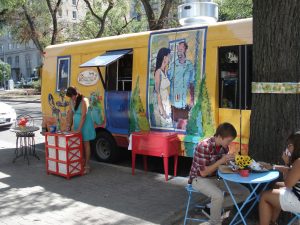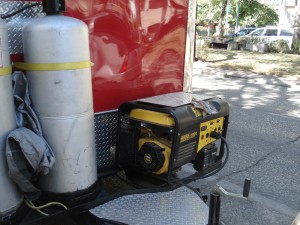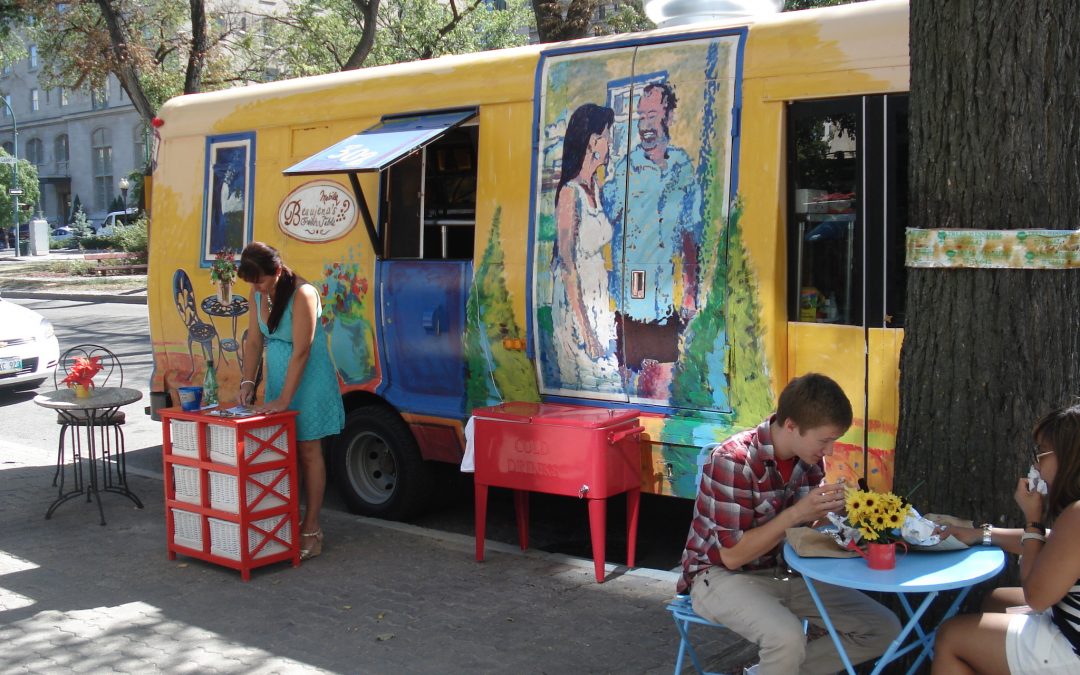Could electricity power the food truck revolution in Winnipeg?
 Food is at the centre of every culture, and culture is at the essence of urban life. Food, culture and cities all must come together to build sustainability. So as Winnipeg opens its palette to new flavours, there are new opportunities for creating a sustainable food culture. What some are calling “the food truck revolution” could have a role to play in building a greener city.
Food is at the centre of every culture, and culture is at the essence of urban life. Food, culture and cities all must come together to build sustainability. So as Winnipeg opens its palette to new flavours, there are new opportunities for creating a sustainable food culture. What some are calling “the food truck revolution” could have a role to play in building a greener city.
Food trucks are a great way of increasing the density of activities in our cites without creating huge new demands on infrastructure. As more areas of North American downtowns shift away from the legacy of zonal segregation that kept offices, shops and residents each in their own quarters, small mobile food trucks are well placed to quickly colonize their broad under-serviced thoroughfares. By making smart use of existing infrastructure, they help bring people together, fostering community development while reducing pressures of sprawl. They also provide low cost start-up opportunities for businesses and increase culinary diversity.
So what can cities do help to encourage food trucks?

Photo: Green Action Centre
There are all kinds of zoning and health issues that need to be resolved for food trucks to work, and Green Action Centre does not have answers to these. But one simple way to make food trucks more accessible is to build plug in stations to provide cheap, clean, noise-free power to food trucks at strategic locations around the city. Get rid of the gas or diesel generators and power food carts with electricity.
Food trucks are not the biggest source of pollution in a city like Winnipeg. Still, switching to plug-in would be easy since many kitchens are already adapted for AC power. Changing over just 20 trucks could reduce greenhouse gas emissions by over 138 tonnes of carbon dioxide per year*. It would be quieter, save vendors money and create new markets for their products.
In other cities like Portland, Oregon, there are food truck parks with plug in stations. Eaters can hear each other; there are no gasoline particles in your burritos, and carbon emissions are reduced. There is no reason we cannot do the same in Winnipeg, starting in some of the areas like Broadway or the Exchange where food carts are already prevalent.
There are plenty of difficult problems that must be solved in shifting to a sustainable, low-carbon economy. Let’s not get stalled on the ones that are easy and tasty for everyone.
* Based on typical consumption of 20 litres gasoline/day, 150 days per year.




An additional 210 tonnes per year?
Excuse my U.S. math.
Following up on the green benefits of electric food trucks. Consider 1000 employees each leaving for lunch and driving 6 miles round trip at 20 mpg, versus 4 food trucks on site to serve the same 1000 people that travel 20 miles at 10mpg
In U.S gallons, 6000 miles at 20 mpg, is 300 gallons.
4 food trucks at 10 mpg, 20 miles would only consume 8 gallons. Net reduction is 292 gallons per day x 250 days per year is 73,000 gallons savings per year per 1000 people. The U.S DOE says that 1 gallon of gasoline emits 19.4 pounds of CO2. Therefore, the CO2 savings would be 73,000 x 19.2, or 1,401,601 lbs of CO2.
I love hot food trucks, but let’s be reasonable, not all people want to eat lunch from a food truck all the time. Let’s assume just 10%, or 1 meal every 2 weeks from the trucks. Winnipeg has a population of ~663,000, with my guesstimate of 1/2 or ~330,000 people working. This equates to 333,000/1000=330 x 1,402,601 lbs x 10% =462 millions of pounds C02 reduction for Winnipeg. ~700 lbs CO2 per year per citizen. At $4/U.S Gallon this would also save Wininipeg’s people over $6 million dollars
What do you think?